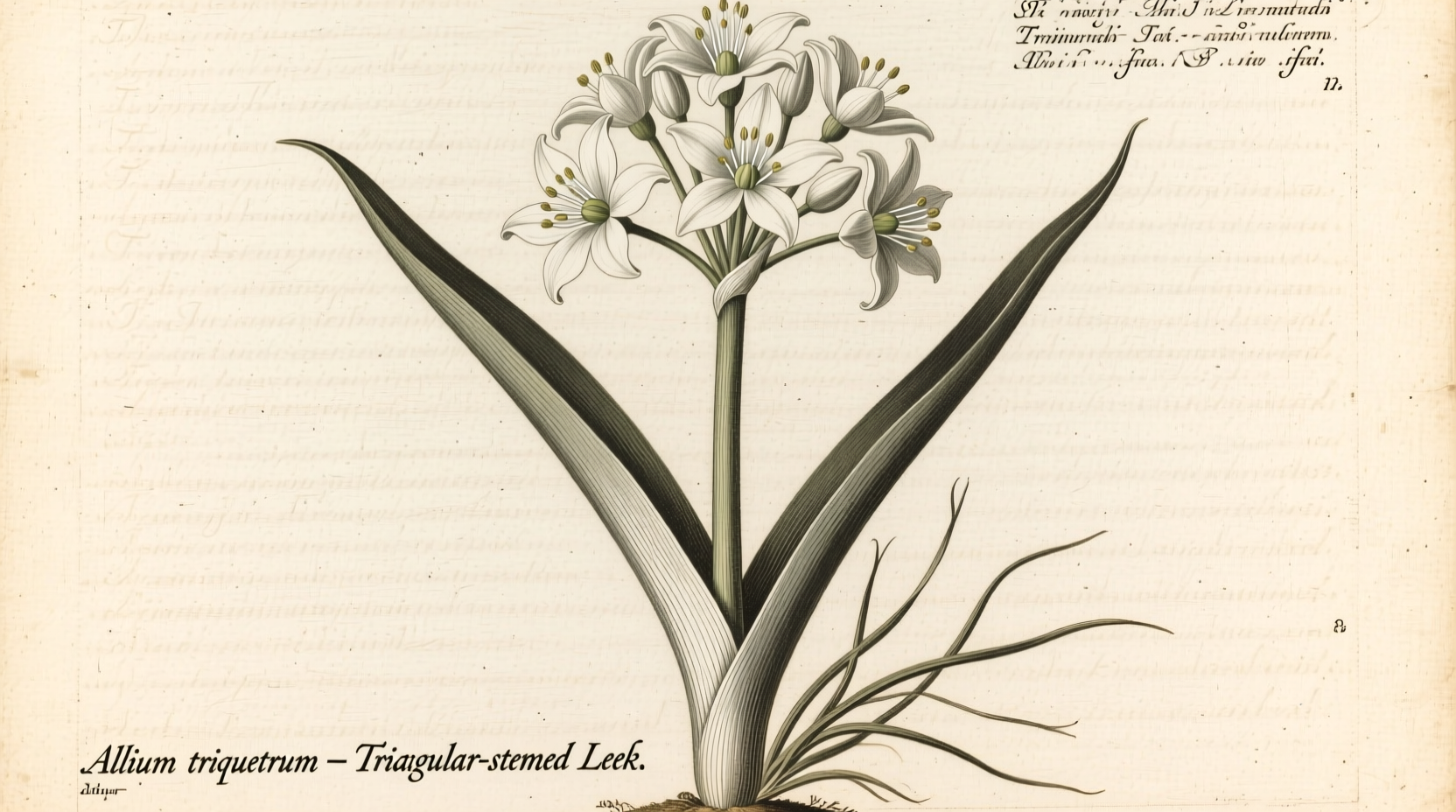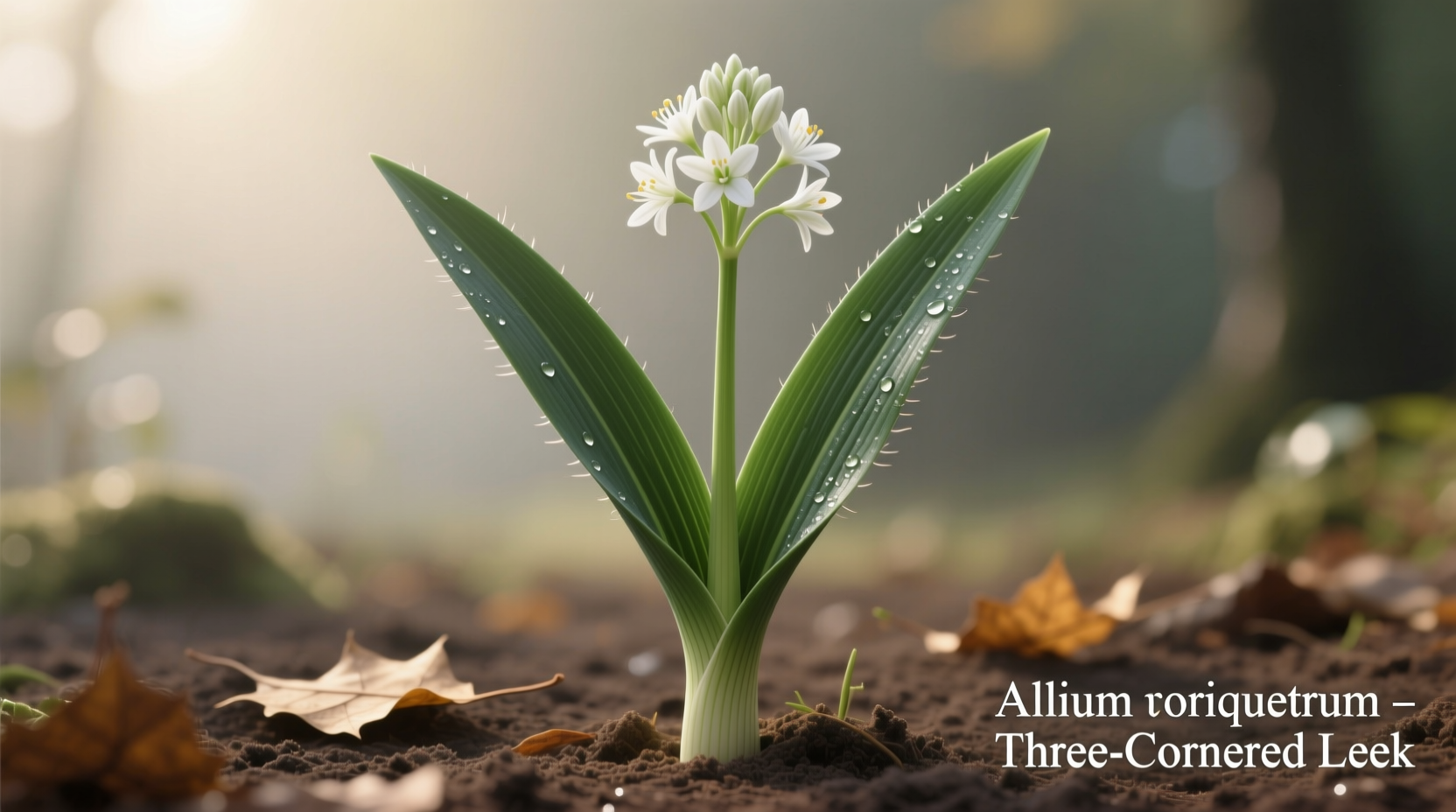Discover how to safely identify, ethically harvest, and creatively use this flavorful wild plant that's been gracing European tables for centuries. Whether you're an enthusiastic forager, home gardener, or culinary explorer, understanding three cornered leek unlocks access to a sustainable, nutrient-rich ingredient that bridges wild food traditions with modern kitchen applications.
What Exactly Is Three Cornered Leek?
Scientifically known as Allium triquetrum, three cornered leek belongs to the Allium genus alongside onions, garlic, and chives. Its distinctive name comes from the plant's most recognizable feature—its three-angled, hollow stem that gives the plant structural rigidity and serves as a key identification marker.
This perennial bulb plant typically reaches 30-60 cm in height during its growing season. In late winter to early spring, it produces delicate white, star-shaped flowers arranged in umbrella-like clusters. When crushed, any part of the plant releases a characteristic garlic-onion aroma that immediately identifies it as a member of the Allium family.

Where Three Cornered Leek Grows Naturally
Native to the Mediterranean basin including Southern Europe, North Africa, and the Middle East, three cornered leek has established itself in temperate regions worldwide. Historical records from the Royal Botanic Gardens, Kew show its introduction to the British Isles as early as the 1700s, where it became naturalized in woodlands and hedgerows.
| Region | Status | First Documented Appearance |
|---|---|---|
| Mediterranean Basin | Native | Prehistoric times |
| British Isles | Naturalized | Early 18th century |
| California, USA | Invasive | Late 19th century |
| Australia | Invasive | Mid-20th century |
The plant's spread timeline reveals how human activity facilitated its global journey. According to the USDA Plants Database, three cornered leek was initially transported as an ornamental or culinary plant before escaping cultivation. In regions like California and Australia, it's now classified as an invasive species that outcompetes native flora in coastal areas and disturbed habitats.
Safe Identification: Avoiding Dangerous Look-Alikes
Proper identification is crucial before harvesting three cornered leek, as several toxic plants share similar early growth characteristics. The most dangerous confusion species include death camas (Toxicoscordion venenosum) and autumn crocus (Colchicum autumnale), both containing potentially fatal compounds.
| Feature | Three Cornered Leek | Death Camas | Autumn Crocus |
|---|---|---|---|
| Stem Shape | Distinctly triangular | Rounded | Rounded |
| Aroma | Garlic/onion scent | No distinctive odor | No distinctive odor |
| Flower Color | White with green stripe | Cream or white | Purple or white |
| Bulb Appearance | Small onion-like bulb | Egg-shaped bulb with fibrous coat | Corm with brown skin |
| Safety | Edible | Poisonous | Poisonous |
Always perform the "crush test"—gently crush a small portion of the leaf or stem. Genuine three cornered leek will immediately release a garlic-onion aroma. If no distinctive scent appears, do not consume the plant. The University of California's Statewide Integrated Pest Management Program emphasizes that proper identification requires examining multiple characteristics simultaneously, not just one feature.
When and Where to Harvest Three Cornered Leek
Understanding the seasonal availability and appropriate harvesting locations ensures both safety and sustainability. Three cornered leek follows a specific growth cycle that varies slightly by climate zone:
- Leaves: Available from late fall through early spring (October-March in Northern Hemisphere)
- Flowers: Bloom in late winter to early spring (February-April)
- Bulbs: Most developed in late spring before dormancy (April-May)
Context boundaries significantly impact harvesting safety. The California Department of Fish and Wildlife specifies that harvesting three cornered leek is permitted in most public lands for personal use, but prohibited in state parks and ecological reserves. Always verify local regulations before foraging, as rules vary considerably by jurisdiction.
Never harvest near roadsides, industrial areas, or locations potentially contaminated with pesticides or heavy metals. The Environmental Protection Agency recommends maintaining at least 100 feet from roadways to avoid vehicle emission contamination.
Culinary Applications: From Wild Harvest to Kitchen
All parts of three cornered leek are edible, each offering slightly different flavor profiles and culinary applications. The leaves provide a mild garlic flavor ideal for raw applications, while the bulbs offer a more pronounced onion-garlic taste perfect for cooking.
Nutritionally, three cornered leek delivers significant benefits according to USDA FoodData Central analysis. A 100g serving contains:
- Approximately 30 calories
- Rich in vitamin C (25% of daily value)
- Good source of calcium and iron
- Contains allicin compounds with antioxidant properties
Chef Sophie Dubois recommends these preparation techniques to maximize flavor:
- Raw applications: Finely chop young leaves for salads, compound butters, or as a garnish for soups and roasted vegetables
- Cooked dishes: Sauté bulbs and lower stems as an aromatic base for soups, stews, and sauces (similar to how you'd use onions)
- Flower uses: Add whole or separated flowers to salads for visual appeal and subtle flavor
- Pesto variation: Blend leaves with walnuts, olive oil, and Parmesan for a unique wild green pesto
"Three cornered leek's versatility makes it a forager's dream," explains Dubois. "The young shoots work beautifully in spring omelets, while the mature bulbs provide depth to winter braises. Unlike cultivated leeks, you get consistent flavor throughout the entire plant."
Ethical Foraging Practices
Responsible harvesting ensures this resource remains available for future generations and minimizes ecological impact. When three cornered leek appears as an invasive species (as in California and Australia), harvesting can actually support ecosystem management.
Follow these ethical guidelines from the North American Foraging Council:
- Never take more than one-third of any single patch
- Use the "rule of three"—leave at least three plants per cluster undisturbed
- Harvest selectively, taking only what you'll use within a few days
- Use clean, sharp tools to minimize plant damage
- Leave the majority of bulbs in the ground to ensure regrowth
In regions where three cornered leek is native or naturalized without causing ecological harm, consider cultivating it in your garden rather than wild harvesting. This Mediterranean plant thrives in USDA zones 7-10 with minimal care once established.
Frequently Asked Questions
Is three cornered leek the same as wild garlic?
No, three cornered leek (Allium triquetrum) differs from wild garlic (Allium ursinum). Wild garlic has flat, broad leaves without the distinctive triangular stem, produces white flowers in a more compact cluster, and has a stronger garlic aroma. Both are edible but represent different species within the Allium genus.
Can I eat three cornered leek raw?
Yes, all parts of three cornered leek can be eaten raw. The young leaves and flowers have a mild garlic-onion flavor perfect for salads and garnishes. The bulbs have a stronger flavor that works well raw when finely minced in dressings or spreads. Raw consumption preserves maximum nutritional value including heat-sensitive vitamin C.
How do I store harvested three cornered leek?
Store fresh three cornered leek in the refrigerator for up to one week. Wrap the stems loosely in a slightly damp paper towel and place in a perforated plastic bag. For longer storage, chop and freeze in ice cube trays with olive oil, or pickle the bulbs for several months of preservation. Avoid washing before storage as excess moisture accelerates spoilage.
Is three cornered leek safe for pets?
No, three cornered leek and other Allium species are toxic to dogs, cats, and other domestic animals. The compounds that make these plants healthy for humans can cause hemolytic anemia in pets. Keep harvested plants away from pets and prevent animals from accessing areas where three cornered leek grows abundantly.











 浙公网安备
33010002000092号
浙公网安备
33010002000092号 浙B2-20120091-4
浙B2-20120091-4